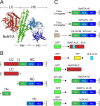Neurotoxin-Derived Optical Probes for Elucidating Molecular and Developmental Biology of Neurons and Synaptic Connections : Toxin-Derived Optical Probes for Neuroimaging
- PMID: 39348040
- PMCID: PMC11634926
- DOI: 10.1007/s11307-024-01954-6
Neurotoxin-Derived Optical Probes for Elucidating Molecular and Developmental Biology of Neurons and Synaptic Connections : Toxin-Derived Optical Probes for Neuroimaging
Abstract
Botulinum neurotoxins (BoNTs) and tetanus toxin (TeTX) are the deadliest biological substances that cause botulism and tetanus, respectively. Their astonishing potency and capacity to enter neurons and interfere with neurotransmitter release at presynaptic terminals have attracted much interest in experimental neurobiology and clinical research. Fused with reporter proteins or labelled with fluorophores, BoNTs and TeTX and their non-toxic fragments also offer remarkable opportunities to visualize cellular processes and functions in neurons and synaptic connections. This study presents the state-of-the-art optical probes derived from BoNTs and TeTX and discusses their applications in molecular and synaptic biology and neurodevelopmental research. It reviews the principles of the design and production of probes, revisits their applications with advantages and limitations and considers prospects for future improvements. The versatile characteristics of discussed probes and reporters make them an integral part of the expanding toolkit for molecular neuroimaging, promoting the discovery process in neurobiology and translational neurosciences.
Keywords: Advanced biomaterials; Fluorescent probes; Fusion proteins; Molecular trafficking; Optical imaging; Retrograde transport; SNARE proteins.
© 2024. Crown.
Conflict of interest statement
Declarations. Conflict of Interest: The authors have no conflict of interest to report.
Figures




Similar articles
-
Neurotoxin-Derived Optical Probes for Biological and Medical Imaging.Mol Imaging Biol. 2023 Oct;25(5):799-814. doi: 10.1007/s11307-023-01838-1. Epub 2023 Jul 19. Mol Imaging Biol. 2023. PMID: 37468801 Free PMC article. Review.
-
[Analysis of synaptic neurotransmitter release mechanisms using bacterial toxins].J Soc Biol. 1999;193(6):457-67. J Soc Biol. 1999. PMID: 10783704 Review. French.
-
[Molecular mechanism of action of tetanus toxin and botulinum neurotoxins].Pathol Biol (Paris). 1994 Feb;42(2):173-82. Pathol Biol (Paris). 1994. PMID: 7916455 Review. French.
-
How botulinum and tetanus neurotoxins block neurotransmitter release.Biochimie. 2000 May;82(5):427-46. doi: 10.1016/s0300-9084(00)00216-9. Biochimie. 2000. PMID: 10865130 Review.
-
Inhibition of neurotransmitter release by botulinum neurotoxins and tetanus toxin at Aplysia synapses: role of the constituent chains.J Physiol (Paris). 1990;84(4):247-61. J Physiol (Paris). 1990. PMID: 1981913
References
Publication types
MeSH terms
Substances
LinkOut - more resources
Full Text Sources

